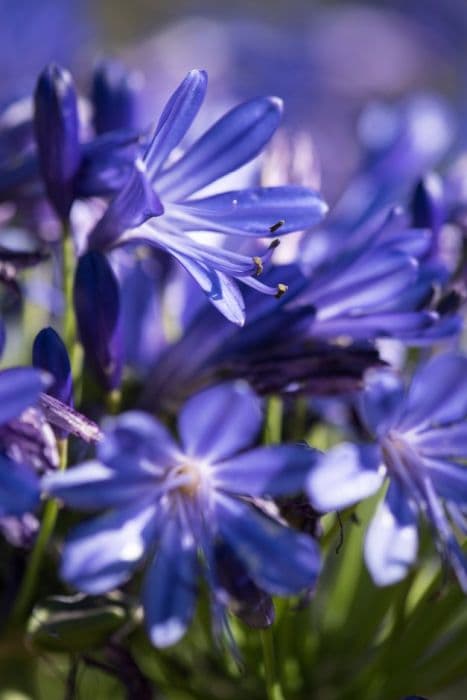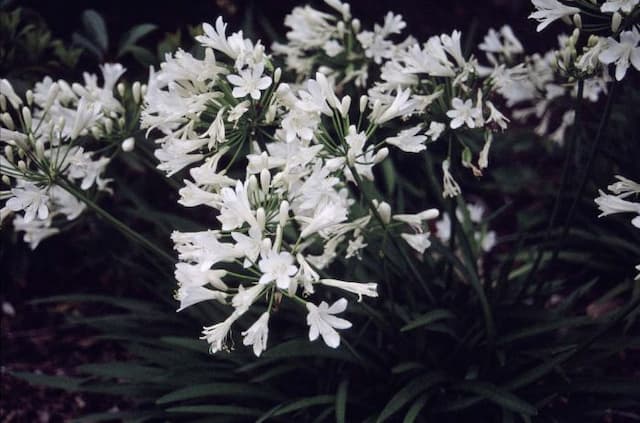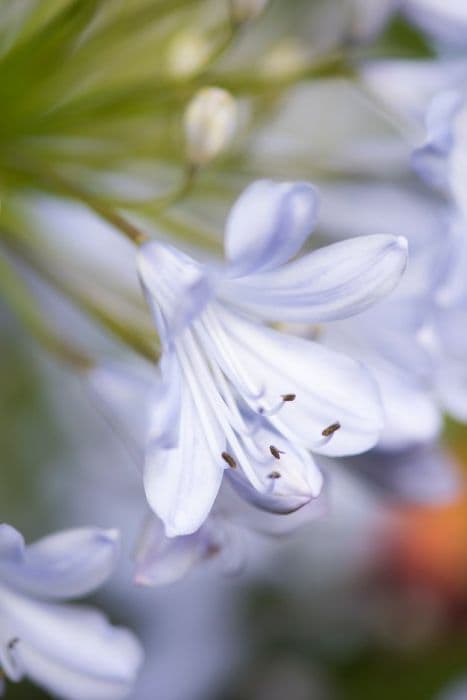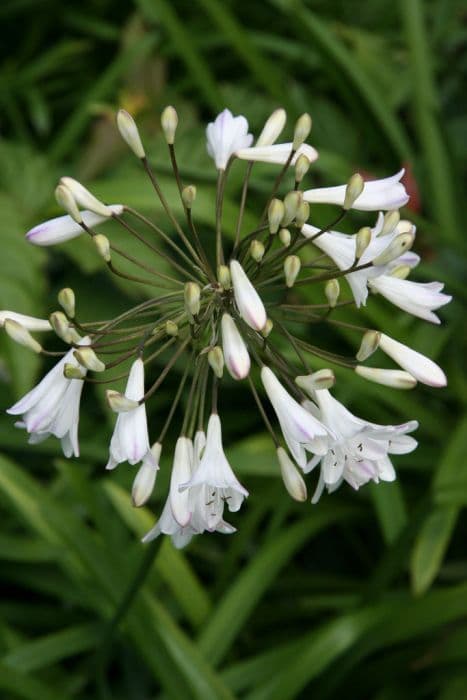African Lily Agapanthus 'Inkspots'

ABOUT
The Agapanthus 'Inkspots', commonly known as Lily of the Nile or African Lily, is admired for its stunning appearance. This variety stands out with its deep blue, almost black flowers, which are arranged in large, globe-shaped clusters at the end of long, sturdy stalks. The blooms are trumpet-shaped and tightly packed together, creating a striking spherical display reminiscent of a burst of fireworks. The foliage of the Agapanthus 'Inkspots' consists of long, strap-like leaves that are lush and arching, forming a dense clump. These leaves are a rich green color, providing a perfect backdrop for the dramatic inflorescences. When in bloom, the contrast between the dark flowers and the verdant foliage draws the eye, making this plant a prominent feature in any garden setting. The overall appearance of the plant is one of elegance and architectural beauty, with its floral symmetry and complementary leaf structure.
About this plant
 Names
NamesFamily
Amaryllidaceae.
Synonyms
African Lily, Lily of the Nile, Love Flower.
Common names
Agapanthus 'Inkspots'
 Toxicity
ToxicityTo humans
The Lily of the Nile is considered mildly toxic to humans if ingested. The plant contains substances that can cause gastrointestinal irritation, nausea, vomiting, and diarrhea. Although generally not life-threatening, consuming parts of this plant can result in an unpleasant experience and may require medical attention if symptoms persist or are severe.
To pets
The Lily of the Nile is toxic to pets, particularly cats and dogs. If ingested, the plant can cause symptoms such as nausea, vomiting, diarrhoea, abdominal pain, and in some cases, excessive salivation or even tremors. The severity of the symptoms can vary depending on the amount ingested and the size of the pet. Pet owners should exercise caution and prevent animals from ingesting any part of the plant to avoid these adverse effects. If a pet is suspected to have ingested Lily of the Nile, it is crucial to seek veterinary care as soon as possible.
 Characteristics
CharacteristicsLife cycle
Perennials
Foliage type
Evergreen
Color of leaves
Green
Flower color
Deep blue
Height
2 feet (0.61 meters)
Spread
2 feet (0.61 meters)
Plant type
Herb
Hardiness zones
8
Native area
South Africa
Benefits
 General Benefits
General Benefits- Attracts Pollinators: Agapanthus 'Inkspots' is known to attract bees, butterflies, and other beneficial pollinators to the garden.
- Low Maintenance: This plant is relatively easy to care for, requiring minimal pruning and upkeep once established.
- Drought Tolerant: It can withstand periods of low water, making it suitable for xeriscaping or drought-prone areas.
- Ornamental Value: With its deep blue or purple flowers, it adds aesthetic appeal and color contrast to garden settings.
- Long Blooming Period: The plant provides flowers throughout the summer, offering a long-lasting display.
- Versatile Landscaping: It can be used in a variety of garden designs, including borders, containers, and as a focal point.
- Tolerates Different Soil Types: Agapanthus 'Inkspots' adapts well to various soil conditions, except extremely wet soils.
- Deer Resistant: The foliage and flowers are not favored by deer, reducing the likelihood of damage in gardens prone to deer visitations.
 Medical Properties
Medical PropertiesThis plant is not used for medical purposes.
 Air-purifying Qualities
Air-purifying QualitiesThis plant is not specifically known for air purifying qualities.
 Other Uses
Other Uses- Agapanthus 'Inkspots' can be used in dried flower arrangements. The flower heads dry well and can retain their shape and color for decorative purposes.
- The plant's strong root system helps to stabilize slopes and prevent soil erosion, making it useful in landscape remediation projects.
- Agapanthus can serve as a privacy screen when planted in a dense row along property boundaries or in front of unsightly views.
- The blooms of the Lily of the Nile can be used as a natural dye source for textiles, yielding hues of blue or purple.
- The fibrous leaves of Lily of the Nile can be used in weaving or basketry for creating ornamental or functional objects.
- Agapanthus 'Inkspots' are often used in wedding bouquets and floral displays due to their striking colors and elegant form.
- In garden ponds or water features, Lily of the Nile can be planted around the margins to create a lush, exotic look.
- The Lily of the Nile can be used as a companion plant in gardens to help deter certain pests due to its thick foliage.
- The sap from the Lily of the Nile can be used as a component in crafting natural adhesives for various artisanal projects.
- Agapanthus 'Inkspots' can be a source of inspiration for artists and photographers looking to capture the distinctive details of its dark purple, almost black flowers in their works.
Interesting Facts
 Feng Shui
Feng ShuiThe plant Agapanthus is not used in Feng Shui practice.
 Zodiac Sign Compitability
Zodiac Sign CompitabilityThe plant Agapanthus is not used in astrology practice.
 Plant Symbolism
Plant Symbolism- Love Letters: Agapanthus, commonly known as Lily of the Nile, is often associated with love letters or messages of love due to its delicate and striking flowers that resemble scripts swirling in the air.
- Enduring Love: The robust nature and long-lasting blooms of the Lily of the Nile symbolize a love that endures over time, withstanding trials and staying strong.
- Beauty: With its deep blue to purple flowers, Lily of the Nile represents beauty, elegance, and a unique aesthetic that is appreciated in many gardens and floral arrangements.
- Strength: Lily of the Nile is known for its hardy stems and vigorous growth, making it a symbol for strength and resilience in the face of adversity.
 Water
WaterThe Lily of the Nile should be watered deeply once a week, supplying about 1 to 1.5 inches of water to thoroughly moisten the soil. If the weather is particularly hot or dry, increase watering frequency to keep the soil evenly moist. During the winter months, reduce the amount of water to prevent root rot, as the plant requires less moisture while dormant. Allow the top inch of soil to dry out before watering again to ensure proper soil moisture balance.
 Light
LightLily of the Nile thrives in full sun to partial shade conditions. A spot that receives at least 6 hours of direct sunlight is ideal for fostering strong growth and abundant flowering. However, in hotter climates, protect the plant from the harsh afternoon sun by providing some light shade.
 Temperature
TemperatureThe Lily of the Nile prefers temperatures between 40°F to 80°F, and can tolerate a minimum temperature of about 20°F for short periods; it is generally hardy in USDA zones 7 through 11. Ideal growing conditions are achieved when nighttime temperatures do not drop below 50°F.
 Pruning
PruningPruning the Lily of the Nile is mainly for removing spent flower stalks and tidying up the plant. Cut back the flower stems to the base after blooming to encourage new growth. In late winter or early spring, remove any dead or damaged leaves to maintain the plant's appearance and health.
 Cleaning
CleaningAs needed
 Soil
SoilAfrican Lily 'Inkspots' requires well-draining, fertile soil with a pH between 6.0 and 8.0. A mix containing loam, compost, and a small amount of sand or perlite is ideal to ensure good drainage and fertility.
 Repotting
RepottingAfrican Lily 'Inkspots' should be repotted every 2-3 years or when it becomes root-bound. Spring is the best time for repotting to minimize stress on the plant.
 Humidity & Misting
Humidity & MistingAfrican Lily 'Inkspots' prefers moderate humidity levels; however, it is quite adaptable and can tolerate the humidity levels typically found in most homes.
 Suitable locations
Suitable locationsIndoor
Place in bright, indirect light, avoid drafts.
Outdoor
Plant in sunny area, shelter from strong winds.
Hardiness zone
8-10 USDA
 Life cycle
Life cycleAgapanthus 'Inkspots', commonly known as Lily of the Nile or African Lily, begins its life cycle with seed germination in favorable conditions of warmth and moisture. The seedlings develop root systems and foliage over the first growing season, forming strap-like green leaves. As the plant matures, it forms a rhizome or elongated bulb-like structure that stores energy and allows the plant to persist through unfavorable conditions. In subsequent years, the plant produces clumps of leaves and in summer, it sends up tall flower stalks topped with a cluster of deep blue or violet flowers. After flowering, seed pods may form, which, upon drying, release seeds to propagate the next generation. The plant then goes into a period of dormancy during colder months, only to resume growth as temperatures rise, repeating its perennial cycle.
 Propogation
PropogationPropogation time
Spring-Early Summer
Agapanthus 'Inkspots', commonly known as Lily of the Nile, is most effectively propagated through division. This is usually done in the spring or fall when the plant is not in active bloom. You begin by carefully digging up the clump of the plant, taking care not to damage the roots. Once the clump is out of the ground, you can gently separate the roots into sections, making sure each new section has a portion of the roots and at least one or two growing points or fans of leaves. These divided sections can then be replanted in well-draining soil at the same depth they were growing previously, spaced about 12 to 18 inches (30 to 45 centimeters) apart to allow room for growth. After planting, water the divisions thoroughly to help establish them in their new location.









![African lily [Blue Storm]](/_next/image?url=https%3A%2F%2Fplants-admin.emdemapps.com%2Fimages%2Fplants%2F%2Fimages%2F604b63200a08b.png&w=640&q=75)